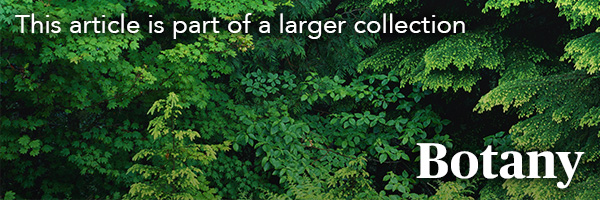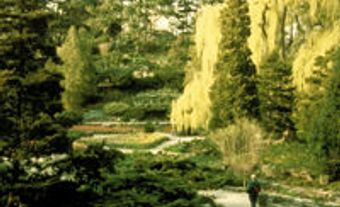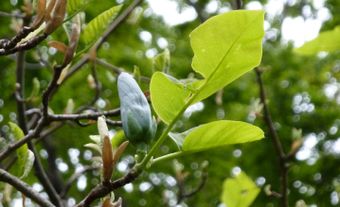
Botany
Botany, the study of plants and plant life, is both a descriptive and an experimental science. It began with the collection of medicinal herbs; in the process, herbalists identified many plants not used in healing. In the Middle Ages, plants known to be effective as medicines were cultivated in herb gardens (see Botanical Gardens). Drugs derived from such plants were important articles of long-distance trade. Botany now studies all aspects of plant life, from the biochemistry of plant pigments to the measurement of total plant production for the planet.
Subdivisions
The study of plant life is organized in 3 ways, which are also applicable to zoological material.
The first scheme divides botanical material into a hierarchy of plant systems based on progressively larger units: molecules, organelles, cells, tissues, organs, whole plants, populations, communities, ecosystems, landscapes, biomes and the biosphere. Examples of levels of organization are large molecules, eg, DNA or chlorophyll; organelle systems, eg, nucleus or chloroplast; cells; tissue systems consisting of several types of cell; and whole plants, which may be as different as tiny planktonic plants and lofty Douglas firs.
Within the hierarchy, each organizational system contains components, including more basic systems and nonliving features (eg, air spaces, oil vacuoles or space between individual plants). Each level, however, is individually integrated, and an understanding of simpler systems does not imply an understanding of higher ones, eg, the behaviour of a whole plant cannot be predicted from knowledge of its cells. The attributes of life (growth, metabolism, reproduction, movement, responsiveness to environment) are equally obvious at each level.
In the second scheme, botanical material is studied as part of a particular group of plants, eg, grasses, lichens, mosses, ferns, trees, weeds.
In the third scheme, botanical material belonging to a particular type of system in the hierarchy and to a particular group of plants is studied from one of several perspectives. Each may be examined in its composition, structure, function, heredity, relation to environment, development, history, classification and distribution. At the whole plant level, these divisions are termed, respectively, anatomy, morphology, physiology, genetics, ecology, genesis, evolution, taxonomy and plant geography.
In Canada interest in plant identification, classification and distribution developed early; however, there are still vast areas for which plant inventories are incomplete. One important historical factor affecting the distribution of plant populations and vegetation in Canada is glaciation. Some botanists believe that the 10 000 years since the retreat of the last ice sheet is too short a period for some plants to have recolonized the whole range of available habitats.
Mapping the migration of these returning plants, and the movement of alien weeds into open or disturbed habitats, gives a historical perspective, as does analysis of fossil pollen (palynology), which traces sequences of types of vegetation inhabiting different parts of Canada since glacial times. Study of evolutionary changes in pigments, cells and tissues gives a historical view at other levels. The development of a single organism at early stages (embryogenesis) may occur in a few days; at the vegetation level, development (succession) may take place over several hundred years.
The ecological focus, a more recent development, attempts to assess the influence of environmental factors on populations, individuals, cells and organelles. Not only well-known environmental factors (eg, temperature, water, energy as food or radiation, minerals, air and harmful or beneficial animals), but also chemical pollutants (eg, acid rain) must now be included as specific environmental factors that operate in concert to affect development, structure and functioning at the various levels of plant organization.
Plant genetics began early with the selection of crop and ornamental plants for yield, flavour, beauty, perfume or medical value. This remains an active area of research for scientists convinced that the balance between food production and increasing human populations can be achieved through the development of more efficient plants. Plant breeders are at the forefront of the "green revolution." Correct environment, with adequate mineral nutrients and water, also contributes to higher crop yields, while crop protection methods ensure that the output survives for human use.
The study of plant genetics has led to successful plant-breeding programs in crop species. For example, the Canadian range of corn has been extended to areas formerly thought to have too short a growing season, and plant breeders can now tailor a specific variety of corn to a particular geographic area. For many plants, multiplication and propagation are solely vegetative, resulting in a large clone of very uniform genetic material. For example, all important varieties of apple are propagated by grafting or budding, and potatoes are seldom produced from seed.
Less welcome results of vegetative propagation can be seen in great overgrowths of pondweeds in waterways (eg, Trent and Rideau systems) and in the Okanagan Valley. These large "nuisance" populations are produced from fragments which separate from parent plants. Although vegetative propagation is common in plants, it is impossible in nature for vertebrate animals in which each individual develops from a fertilized egg.
All life on earth is dependent on green plants storing energy in chemical bonds and producing oxygen, and on nongreen plants making available the minerals that are essential for growth. Nongreen plants (like most other living things) are "heterotrophic" and must get energy for life processes in the form of chemical compounds. Green plants' energy requirements are met through photosynthesis. Examination of the process of energy use by green plants has shown, however, that up to 50% of all energy fixed by at least some green plants "leaks out" again and is lost. Until a clearly defined function for these "escaped" substances is found, the system must be considered inefficient.
An understanding of the development of plant structure contributes to our view of the functions of cells, tissues, plants and vegetation, and may lead to better control of growth. Techniques developed for the electron microscope, in which electrons are either passed through thin tissue sections or bounced off plant material, are used to examine composition, structure and development. Many details of plant structure at the tissue and cell level, formerly hidden because of small size, have been revealed by these methods, and new techniques continue to be developed to display further the elegance of life within cells. All institutions in Canada that research plant structure use both transmission electron microscopes and scanning electron microscopes.
Applications
Natural drugs, dyes, flavours and spices produced by plants have been important since ancient times. Recently, many of these have been replaced by synthetic copies. Aspects of agriculture dealing with plants that have botany as a foundation include crop production, horticulture, pasture renovation, market gardening, crop breeding, forestry, flower production, landscape architecture and wildlife conservation and management. In addition, many poisonous plants must be understood so that their deleterious effects can be reduced. Botany, therefore, contributes in various ways to the health, welfare and happiness of Canadians.
Fields of Work
Botanists are employed by federal and provincial governments and as consultants in industry. They also teach in universities, colleges and schools. Their endeavours may be academic ("pure" research) or applied to solving problems of economic or other significance. Frequently, they co-operate with zoologists, meteorologists, soil scientists, oceanographers or other scientists.
Societies
Studies undertaken by botanists are diverse and depend upon level of hierarchy, type of plant material and focus of interest. As a result, membership of the several botany-related societies in Canada does not fully reflect the botanical interests of Canadian botanists, who also belong to international societies. If a botanist classifies lichens, he is likely to join a society where he will meet individuals from other countries (eg, Australia or Finland) primarily interested in lichens, rather than joining a Canadian society of less specific focus. The botanist studying population dynamics of algae would have more in common with members of a society dealing with populations (plant and animal) than a society devoted to algae classification.
Some Canadian associations that include botanists in their membership are the Canadian Botanical Assn, Royal Society of Canada, Canadian Society of Plant Physiologists, Canadian Phytopathological Society, Association canadienne-française pour l'avancement des sciences, Agricultural Institute of Canada, Arctic Institute of North America, Canadian Forestry Association, Canadian Institute of Forestry, Canadian Society for Cell Biology, Canadian Society of Cytology, Canadian Society of Environmental Biologists, Canadian Society of Microbiologists, Genetics Society of Canada, Canadian Biochemical Society, Canadian Society of Landscape Architects, Canadian Ornamental Plant Foundation, Jeunes biologistes du Québec, and the various provincial institutes of agrologists. There are 80 local or provincial naturalists' clubs.
Journals published in Canada include Canadian Journal of Botany, Canadian Journal of Plant Science, Canadian Journal of Microbiology, Canadian Journal of Genetics and Cytology (since 1 January 1987, Genome), Canadian Journal of Plant Pathology, Canadian Journal of Forest Research, Le Naturaliste canadien, Canadian Field Naturalist, Ontario Field Biologist.

 Share on Facebook
Share on Facebook Share on X
Share on X Share by Email
Share by Email Share on Google Classroom
Share on Google Classroom




